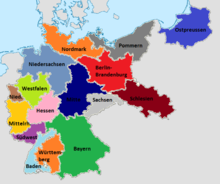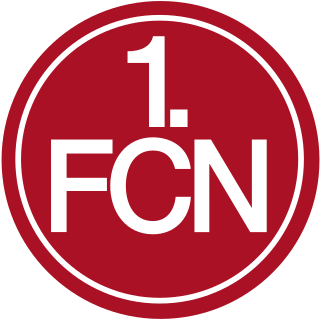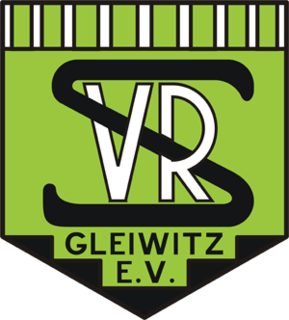| Season | 1935–36 |
|---|---|
| Champions | 16 regional winners |
| German champions | 1. FC Nürnberg 6th German title |
← 1934–35 1936–37 → | |

The 1935–36 Gauliga was the third season of the Gauliga, the first tier of the football league system in Germany from 1933 to 1945.

A Gauliga was the highest level of play in German football from 1933 to 1945. The leagues were introduced in 1933, after the Nazi takeover of power by the Sports office of the Third Reich.
The German football league system, or league pyramid, refers to the hierarchically interconnected league system for association football in Germany that in the 2016–17 season consists of 2,235 divisions having 31,645 teams, in which all divisions are bound together by the principle of promotion and relegation. The top three professional levels contain one division each. Below this, the semi-professional and amateur levels have progressively more parallel divisions, which each cover progressively smaller geographic areas. Teams that finish at the top of their division at the end of each season can rise higher in the pyramid, while those that finish at the bottom find themselves sinking further down. In theory it is possible for even the lowest local amateur club to rise to the top of the system and become German football champions one day. The number of teams promoted and relegated between the divisions varies, and promotion to the upper levels of the pyramid is usually contingent on meeting additional criteria, especially concerning appropriate facilities and finances.

Germany, officially the Federal Republic of Germany, is a country in Central and Western Europe, lying between the Baltic and North Seas to the north, and the Alps to the south. It borders Denmark to the north, Poland and the Czech Republic to the east, Austria and Switzerland to the south, France to the southwest, and Luxembourg, Belgium and the Netherlands to the west.
Contents
The league operated in sixteen regional divisions, of which two, the Gauliga Ostpreußen and Gauliga Pommern, were sub-divided into four and two regional groups respectively, with the league containing 183 clubs all up, eleven more than the previous season. The league champions entered the 1936 German football championship, won by 1. FC Nürnberg who defeated Fortuna Düsseldorf 2–1 in the final. It was Nürnberg's sixth national championship, the club's only one during the Gauliga era of German football from 1933 to 1945. [1]

The Gauliga Ostpreußen was the highest football league in the Prussian province of East Prussia and the Free City of Danzig from 1933 to 1945. Shortly after the formation of the league, the Nazis reorganised the administrative regions in Germany, and the GauEast Prussia the Prussian province. Danzig however did not became part of this Gau, being integrated in the Gau Danzig-West Prussia in 1939 instead.

The Gauliga Pommern was the highest football league in the Prussian province of Pomerania (German:Pommern) from 1933 to 1945. Shortly after the formation of the league, the Nazis reorganised the administrative regions in Germany, and the GauPomerania replaced the province of Pomerania.
The 1936 German football championship, the 29th edition of the competition, was won by 1. FC Nürnberg by defeating Fortuna Düsseldorf 2–1 after extra time in the final. It was Nuremberg's sixth championship and its first since 1927. Fortuna Düsseldorf made its second final appearance, having previously won the competition in 1933 but, after 1936, the team would never appear in the final again. Nuremberg had eliminated the champions of the previous two seasons, Schalke 04 in the semi-finals, making 1936 the only final from 1933 to 1942 not to include the club. Schalke however would return to its winning ways the following season when it defeated Nuremberg in the 1937 final.
Three clubs remained unbeaten during the league season: Hindenburg Allenstein, FC Schalke 04 and 1. FC Nürnberg. Of those three Nürnberg would go on to remain unbeaten during the German championship as well while Schalke would suffer two defeats, one of them in the semi-finals to Nürnberg, while Allenstein would lose all six finals games. At the other end of the table only one club finished the season without a win, SpVgg Feuerbach. FC Schalke 04 scored the most goals of any Gauliga club with 94 while SC Dresdenia Dresden conceded the most with 72. FC Schalke 04 achieved the highest points total with 35 while SV Insterburg earned the least with two points to its name. [2]

Fußballclub Gelsenkirchen-Schalke 04 e. V., commonly known as FC Schalke 04, Schalke or abbreviated as S04, is a professional German association-football club and multi-sports club originally from the Schalke district of Gelsenkirchen, North Rhine-Westphalia. The "04" in the club's name derives from its formation in 1904. Schalke has long been one of the most popular professional football teams and multi-sports club in Germany, even though the club's heyday was in the 1930s and 1940s. Schalke play in the Bundesliga, the top tier of the German football league system. As of June 2018, the club has 155,000 members, making it the second-largest sports club in Germany and the fourth-largest sports club in the world in terms of membership. Other activities offered by the club include athletics, basketball, handball, table tennis, winter sports and eSports.

1. Fußball-Club Nürnberg Verein für Leibesübungen e. V., often called 1. FC Nürnberg or simply Nürnberg, is a German association football club in Nuremberg, Bavaria, who currently compete in the Bundesliga. Founded in 1900, the club initially competed in the Southern German championship, winning their first title in 1916. Their first German championship was won in 1920. Before the inauguration of the Bundesliga in 1963, 1.FCN won a further 11 regional championships, including the Oberliga Süd formed in 1945, and were German champions another seven times. The club has won the Bundesliga once and the DFB-Pokal four times.
The 1935–36 season saw the second edition of the Tschammerpokal, now the DFB-Pokal. The 1936 edition was won by VfB Leipzig, defeating FC Schalke 04 2–1 on 3 January 1937. [3]

The DFB-Pokal[ˈdeː ʔɛf beː poˈkaːl] is a German knockout football cup competition held annually by the Deutscher Fußball-Bund (DFB). Sixty-four teams participate in the competition, including all clubs from the Bundesliga and the 2. Bundesliga. It is considered the second-most important club title in German football after the Bundesliga championship. Taking place from August until June, the winner qualifies for the DFL-Supercup and the UEFA Europa League unless the winner already qualifies for the UEFA Champions League in the Bundesliga.
The 1936 Tschammerpokal was the 2nd season of the annual German football cup competition. A total of 5,291 teams competed in the qualifying tournament which was divided into four stages. The final stage ended with the final which was held on 3 January 1937 in the Olympiastadion in Berlin. VfB Leipzig defeated last year's runner up, Schalke 04, 2–1.
